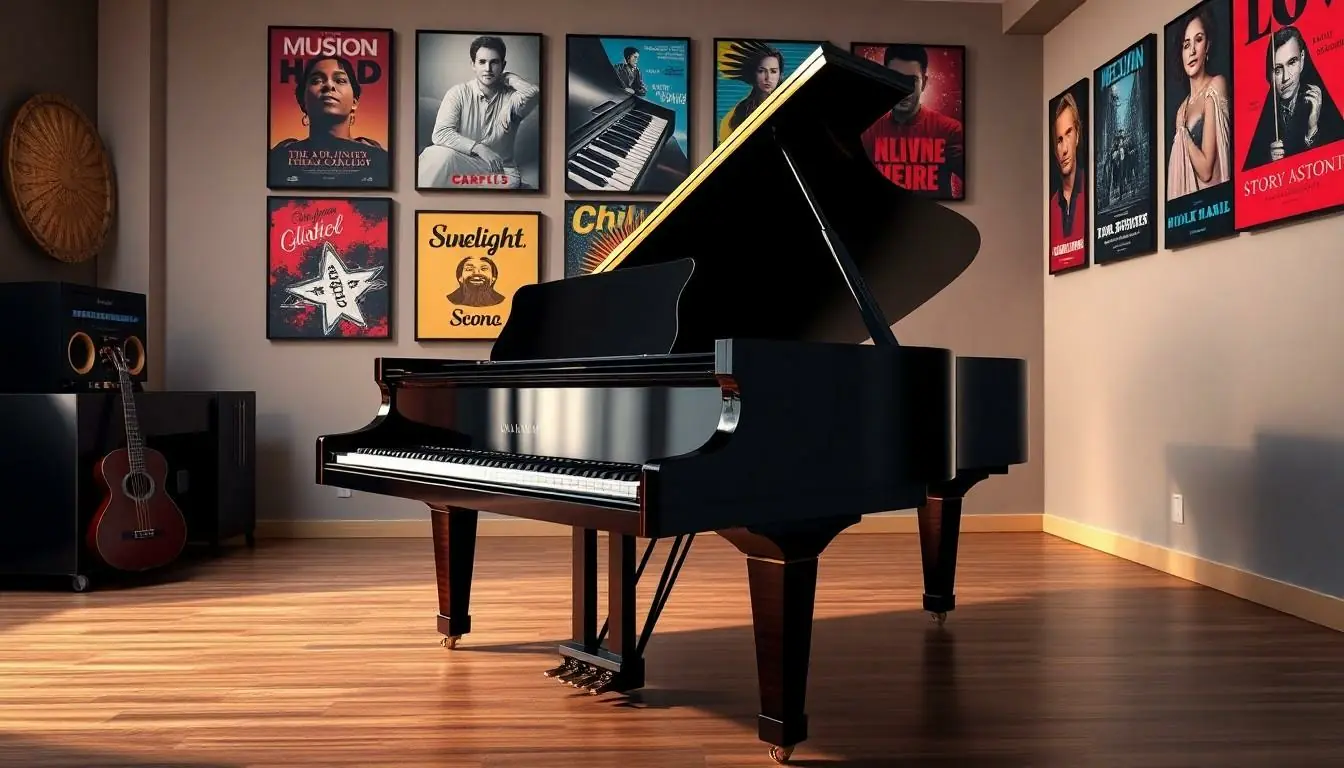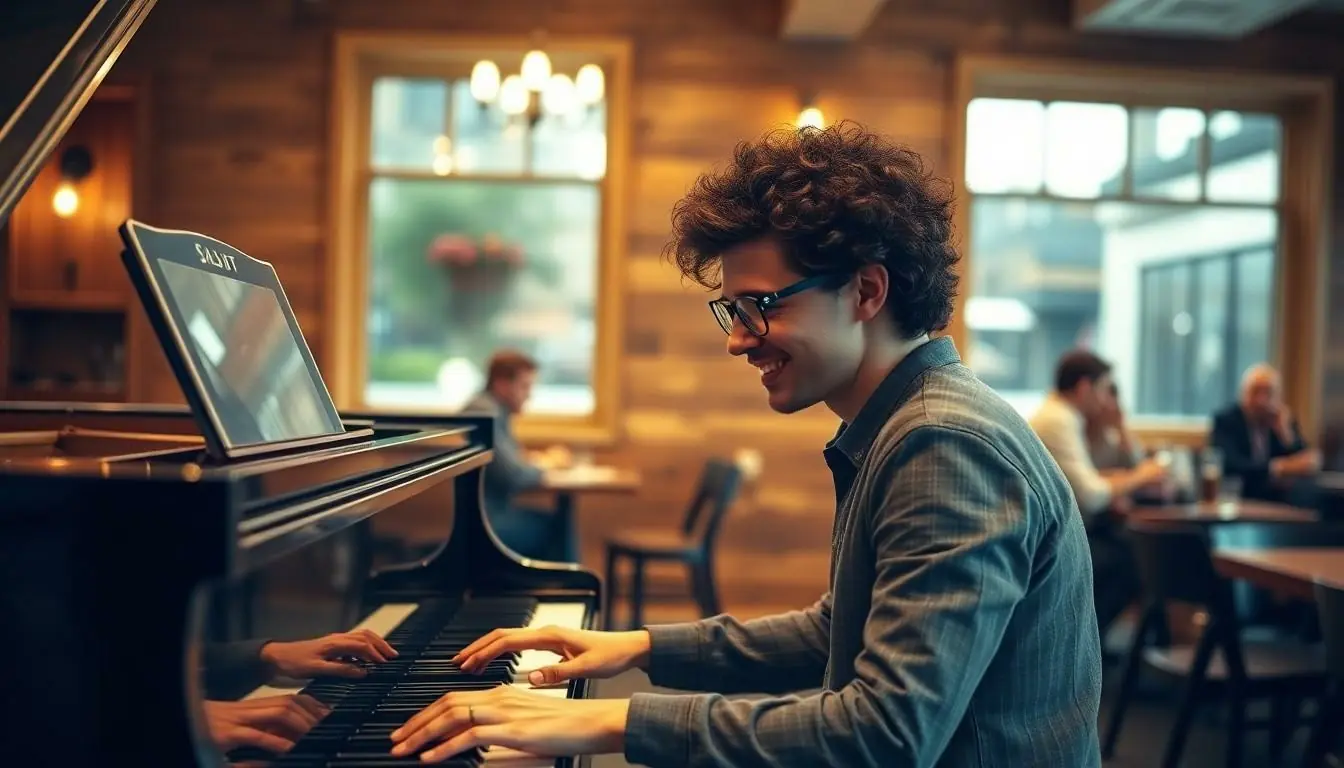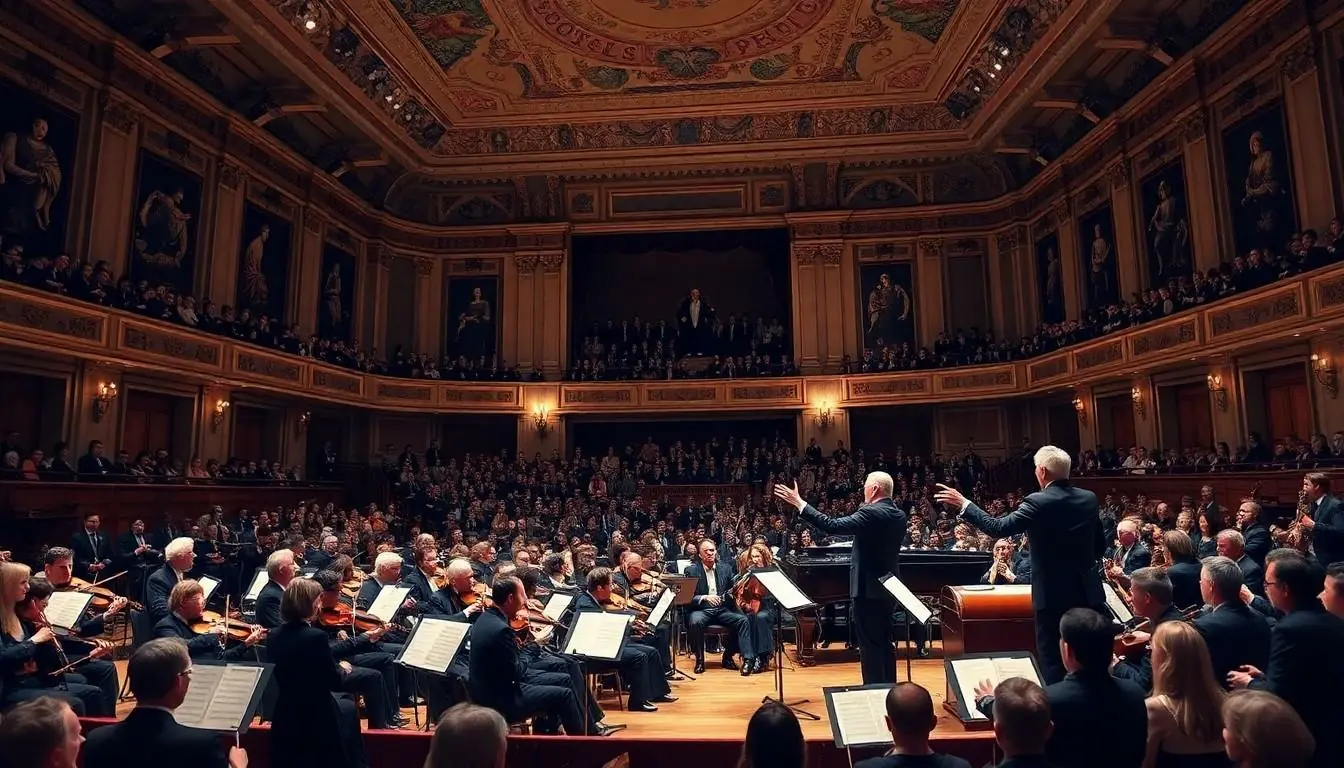Pop piano music has a way of sneaking into hearts and playlists, often when least expected. It’s that delightful blend of catchy melodies and emotional depth that can make even the most stoic person tap their feet. Whether it’s the latest chart-topper or a timeless classic, the piano brings a unique flair that turns ordinary tunes into unforgettable anthems.
Imagine a world where every coffee shop hums with the sounds of a piano, where every romantic dinner is accompanied by a soft, melodic backdrop. Pop piano music isn’t just for the professionals; it invites everyone to join in the fun. With its infectious energy and relatable lyrics, it’s no wonder this genre has become a staple in our daily lives. So grab a seat, maybe a snack, and let’s dive into the captivating world of pop piano music that’s sure to hit all the right notes.
Table of Contents
ToggleOverview of Pop Piano Music
Pop piano music blends simplicity with emotional richness. Catchy melodies intertwined with lyrics resonate deeply, creating an avenue for diverse expression. This genre offers an inviting soundscape that complements various settings, including cafes and intimate gatherings.
Listeners often find solace in its familiar chord progressions and rhythmic patterns. Instruments in pop piano tracks typically highlight the piano’s versatility, allowing artists to explore different themes and moods. Prominent pop piano songs often feature a balance between upbeat tempos and slower, reflective moments.
Artists like Elton John, Billy Joel, and Adele exemplify the genre’s ability to connect with audiences. Each of these musicians showcases unique attributes, drawing in fans across generations. Chart-topping hits often incorporate piano arrangements that enhance both the emotion and storytelling.
Educational institutions increasingly embrace pop piano music within curricula. Students learn its techniques alongside classical methods, ensuring a well-rounded musical foundation. Schools often host competitions featuring popular pieces, encouraging young pianists to gain performance experience.
Pop piano music continues to evolve, adapting to contemporary trends. Emerging artists introduce innovative styles while paying homage to classic influences. As it transitions, the genre maintains its charm, captivating new audiences and ensuring relevance in an ever-changing musical landscape.
Origins and Evolution

Pop piano music traces its roots to a mix of classical, jazz, and folk styles. This genre emerged in the early 20th century, with piano playing a central role in popular music settings.
Early Influences
Classical composers like Chopin and Liszt greatly influenced early pop piano music. Their emotive melodies inspired subsequent generations of musicians. Jazz brought improvisation and syncopation to the piano, enriching its adaptability. Artists like Fats Waller and Duke Ellington showcased how the piano could convey complex emotions. Folk traditions also contributed, using simple chord progressions and relatable themes. This eclectic foundation shaped the music that resonates today.
Modern Developments
In recent decades, pop piano music has undergone significant transformation. Electronic elements now blend with traditional sounds, creating diverse listening experiences. Contemporary artists like John Legend, Sam Smith, and Taylor Swift highlight this evolution. Collaborations between genres, such as pop and R&B, broaden the genre’s appeal. Additionally, streaming platforms allow for greater exposure and experimentation, helping new artists connect with global audiences. Emerging trends emphasize emotional storytelling, ensuring pop piano music stays relevant in today’s musical landscape.
Key Characteristics of Pop Piano Music
Pop piano music features distinct characteristics that define its engaging sound. This genre typically employs simple yet catchy melodies that resonate with a wide audience.
Melodic Elements
Catchiness defines the melodies in pop piano music. Singable tunes often dominate the music, allowing listeners to easily hum along. Repetition creates familiarity, reinforcing the memorable nature of the songs. Many artists incorporate simple motifs that develop throughout compositions, maintaining listener engagement. Influential figures like Elton John and Adele showcase these melodic structures, making their music widely recognizable.
Harmonic Structure
Harmonically, pop piano music leans on accessible chord progressions. Common progressions like I-IV-V and vi-IV-V enhance the genre’s appeal. These structures create a foundation that supports both emotional expression and melodic exploration. The use of major and minor chords adds depth to the overall sound, allowing artists to convey various feelings. Compelling harmonic shifts often accompany lyrical themes, enriching the listening experience and fostering emotional connections.
Notable Pop Piano Artists
Pop piano music boasts a range of talented artists who significantly influence the genre. Their music captures the hearts of listeners through dynamic melodies and heartfelt lyrics.
Iconic Performers
Elton John remains a monumental figure in pop piano music. His knack for blending catchy tunes with emotional depth resonates widely. Billy Joel also attracts attention with his storytelling capabilities, creating timeless classics that span generations. Adele has redefined pop through her powerful vocal performances and poignant piano ballads. Each of these performers showcases unique abilities, making them essential to the genre’s landscape.
Emerging Talents
Emerging artists are revitalizing pop piano music. Olivia Rodrigo draws in young audiences with her relatable lyrics and fresh melodies. In addition, Sam Fender combines emotional expression with modern pop influences, appealing to both old and new fans. Retro-inspired sounds from artists like Låpsley highlight the genre’s evolution while honoring its roots. These newcomers continue to shape and expand the reach of pop piano music in exciting ways.
The Role of Pop Piano Music in Contemporary Culture
Pop piano music plays a significant role in shaping contemporary culture. This genre serves as the backdrop for various social settings, including cafes, weddings, and intimate gatherings. Artists like Elton John and Adele create emotional connections that resonate deeply with listeners. Each performance draws people in, fostering shared experiences through music.
Educational institutions recognize the importance of pop piano music within their curricula. Students often learn popular songs along with classical pieces, enhancing their musical versatility. Competitions featuring pop piano music encourage young pianists to engage with the genre actively. These events provide critical platforms for emerging talent and stimulate interest in the art form.
Emotional storytelling remains a hallmark of pop piano music. Noteworthy artists such as John Legend and Sam Smith utilize compelling narratives to deepen listener engagement. Lyrics often reflect personal experiences, allowing audiences to find solace and connection in shared feelings. This ability to convey relatable emotions helps the genre maintain its relevance over time.
Streaming services further amplify the reach of pop piano music. Platforms like Spotify and Apple Music allow for easy discovery of both established and emerging artists. Each stream brings new talent into the spotlight, ensuring a continual evolution of musical styles. The blending of genres often leads to innovative sounds, capturing the attention of diverse audiences.
Cultural events and media prominently feature pop piano music. Films, television series, and commercials often utilize popular piano pieces to evoke specific moods. This strategic use enhances narrative depth, demonstrating the genre’s versatility. Cultural phenomena, including viral TikTok trends, showcase the genre’s adaptability and enduring appeal.
Pop piano music continues to enchant listeners with its blend of catchy melodies and emotional depth. Its accessibility makes it a beloved choice in various settings, from cozy cafes to romantic evenings. The genre thrives on its ability to evoke feelings and create connections, showcasing the talent of both established and emerging artists.
As it evolves, pop piano music remains relevant by incorporating modern influences while honoring its rich history. Educational institutions recognize its significance, fostering a new generation of pianists who engage with its techniques. With its profound impact on contemporary culture, pop piano music is sure to resonate for years to come, inviting everyone to experience its magic.




